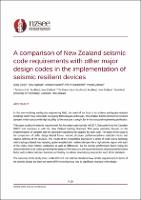A comparison of New Zealand seismic code requirements with other major design codes in the implementation of seismic resilient devices

Download
Date
2021-04-14Authors
Varier, Sriraj
Agarwal, Setu
Hashemi, Ashkan
Quenneville, Pierre
Zarnani, Pouyan
Metadata
Show full item recordAbstract
In the ever-evolving earthquake engineering field, the need of the hour is to achieve earthquake-resistant buildings which have immediate occupancy following an earthquake. This implies that the demand for resilient dampers which can provide high ductility to the structure is sought for in the structural engineering profession.
This paper studies the seismic requirements for the major codes namely ASCE-7, Eurocode 8 and the Canadian NBCC and compares it with the New Zealand loading Standard. This paper primarily focuses on the implementation of dampers and the procedure required to be adopted for each code. The basis of the study is the comparison of drifts, design lateral forces, seismic structural performance/force reduction factor and relative stiffness of the structure. The results of the comparative analysis on a series of multi-storey buildings with bracing as lateral load resisting system enabled with resilient dampers for a high seismic region with each of the codes show notable similarities as well as differences. As the seismic performance factor being the critical element in all codes governing the design of the structure, the assumed seismic structural performance factor with resilient dampers has been verified by non-linear time history analysis for each of the standards.
The outcomes of the study show, while different international standards have similar requirements in terms of the seismic design but there are some differences that may lead to significant changes in the design.
